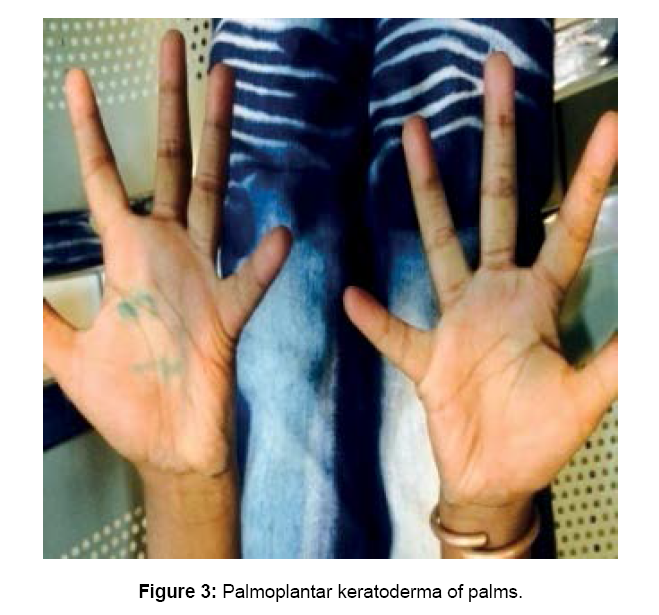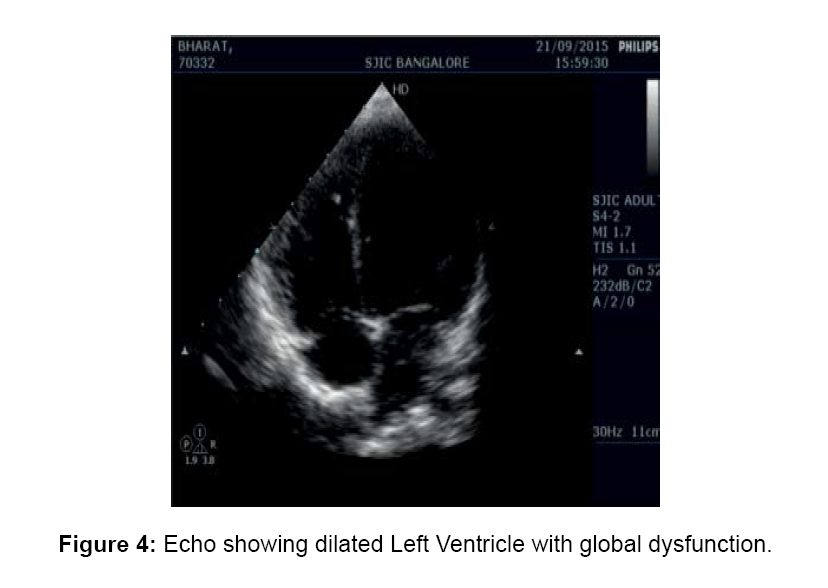Carvajal Syndrome: A Rare Variant of Naxos Disease
Received: 24-Dec-2015 / Accepted Date: 18-Jan-2016 / Published Date: 25-Jan-2016
Abstract
Carvajal syndrome also known as ‘Striate palmoplantar keratoderma with woolly hair and cardiomyopathy is a cutaneous condition inherited in an autosomal recessive pattern due to a defect in desmoplakin gene. The skin disease presents as a striate palmoplantar keratoderma particularly at sites of pressure. The patient is at risk of sudden cardiac death due to dilated cardiomyopathy associated with this entity. A variant of Naxos disease,reported as Carvajal syndrome, has been described in families from India and Ecuador. Clinically, it presents with the same cutaneous phenotype and predominantly left ventricular involvement
Keywords: Carvajal syndrome; Naxos disease; Striate palmoplantar; Autosomal recessive keratoderma
77796Introduction
Carvajal syndrome also known as ‘Striate palmoplantar keratoderma with woolly hair and cardiomyopathy is a cutaneous condition inherited in an autosomal recessive pattern due to a defect in desmoplakin gene. The skin disease presents as a striate palmoplantar keratoderma particularly at sites of pressure. The patient is at risk of sudden cardiac death due to dilated cardiomyopathy associated with this entity. A variant of Naxos disease, reported as Carvajal syndrome, has been described in families from India and Ecuador. Clinically, it presents with the same cutaneous phenotype and predominantly left ventricular involvement.
Case Report
11 years old boy presented with cough, breathlessness and easy fatigue ability for 3 months duration. On general examination the pt had fine brittlle lusterless scalp hair, pallor, stomatitis, keratotic skin over palm, sole and lower half of both lower limbs (Figures 1-3). Pt has tachycardia with HR 140/min, RR 40/min, BP 80/60 mmhg, SPO2 72%, raised JVP, with B/L basal crepitation’s, S3 gallop present. Echocardiographic examination revealed a dilatation of the right and left ventricles with a left ventricular ejection fraction of 35% and biventricular trabecular configuration, predominantly of the left ventricle and also grade I tricuspid and Mitral valve insufficiency (Figures 4 and 5). Patient was treated with diuretics, beta-blockers’ and ACE inhibitors.
Discussion
Naxos disease was first described by Protonotarios et al. in families originating from the Greek island of Naxos [1]. It is caused by a recessive mutation in desmoplakin, which maps to 17q21 gene, an intracellular protein that links desmosomal adhesion molecules to intermediate filaments of the cytoskeleton. Patient usually presents with Woolly hair since birth; palmoplantar kearatosis develops during first year of life and cardiomyopathy (Rt.ventricular) in adolescence [1-4]. A particular mutation that truncates the intermediate filament-binding site of desmoplakin results in a variant of Naxos disease with predominantly left ventricular involvement, early morbidity and clinical overlapping with dilated cardiomyopathy has been described by Kaplan et al. [5] from Ecuador as Carvajal Sydrome. It is a progressive heart disease and may cause sudden death in a child with early age. Whenever a child presents with such a dermatological manifestation, the paediatric cardiologist’s consultation must be done at earliest possible. The differences between Naxos syndrome and Carvajal syndrome is depicted in Table 1. The primary goal of the management is to prevent sudden cardiac death. Implantation of automatic cardioverter defibrillator, antiarrhythmic drugs and management of heart failure are the recommended treatment modalities [6]. The population at risk should be genetically screened.
| NAXOS SYNDROME | CARVAJAL SYNDROME |
|---|---|
| Arrhythmogenic right ventricular dysplasia.1 | Left ventricular involvement |
| Deletion in the plakoglobin gene | Mutations of the desmoplakin gene |
| Clinically manifests in adolescence. Patients may develop progressive heart disease involving the right or both ventricles. Symptoms of right heart failure are found in the final stages when the right or both ventricles are severely affected.1 | Clinically apparent earlier during childhood as DCM. Fifty percent of affected patients develop heart failure, and most of them die during adolescence. |
| ECG: inverted T waves in V1 - V3 or QRS complex prolongation in leads V1 -V3, Epsilon waves, and complete or incomplete RBBB. | ECG: low voltage and intraventricular conduction defects. T-wave inversion in V1, V2, or V3 or extended to V5 observed.2 |
| Cardiac histology reveals the characteristic loss of the right ventricular myocardium with fibrofatty replacement | Cardiac histology of the Carvajal disease shows areas of extensive myocardial loss and replacement with fibrosis that is very similar to arrhythmogenic right ventricular dysplasia/cardiomyopathy pathology but without the fatty component.4 |
| The affected members of both syndromes have woolly hair at birth, whereas palmoplantarkeratoderma appears during the first year of life, when infants start using their extremities.3 | |
Table 1: Showing the differentiating features between Naxos and Carvajal Syndrome.
Conclusion
The cardiomyopathy in Naxos syndrome and Carvajal cardiocutaneous syndromes presents with increased arrhythmogenicity and variable left ventricular involvement and is characterized histologically by myocardial loss with fibrofatty or fibrous replacement at subepicardial and mediomural layers. The clinical heterogeneity and tissue characteristics in this cell-adhesion cardiomyopathy might be mutation specific and leads to consideration that the spectrum of ARVC should be broadened.
References
- Protonotarios N, Tsatsopoulou (2004) A-Naxos disease and Carvajal syndrome: cardiocutaneous disorders that highlight the pathogenesis and broaden the spectrum of arrhythmogenic right ventricular cardiomyopathy. Cardiovasc Path 13: 185-194.
- Peirone A, Bruno E, Rossi N, Alday LE (2005) Woolly hair and palmoplantar hyperkeratosis may present with hypertrophic cardiomyopathy. Pediatr Cardiol 26: 470-472.
- Krishnamurthy S, Adhisivam B, Hamilton RM, Baskin B, Biswal N, et al. (2011) Arrhythmogenic dilated cardiomyopathy due to a novel mutation in the desmoplakin gene. Indian J Pediatr 78: 866-869.
- Rai R, Ramachandran B, Sundaram VS, Rajendren G, Srinivas CR (2008) Naxos disease: a rare occurrence of cardiomyopathy with woolly hair and palmoplantarkeratoderma. Indian J Dermatol Venereol Leprol 74: 50-52.
- Kaplan SR, Gard JJ, Carvajal-Huerta L, Ruiz-Cabezas JC, Thiene G, et al. (2004) Structural and molecular pathology of the heart in Carvajal syndrome. Cardiovasc Pathol 13: 26-32.
- Corrado D, Leoni L, Link MS, Della Bella P, Gaita F, et al. (2003) Implantable cardioverter-defibrillator therapy for prevention of sudden death in patients with arrhythmogenic right ventricular cardiomyopathy/dysplasia. Circulation 108: 3084-3091.
Citation: Madhu KJ, Vijyalakshmi IB, Narsimhan C, Manjunath CN (2016) Carvajal Syndrome: A Rare Variant of Naxos Disease. Cardiovasc Ther 1: 103.
Copyright: © 2016 Madhu KJ, et al. This is an open-access article distributed under the terms of the Creative Commons Attribution License, which permits unrestricted use, distribution, and reproduction in any medium, provided the original author and source are credited.
Share This Article
Open Access Journals
Article Usage
- Total views: 20853
- [From(publication date): 2-2016 - Apr 20, 2025]
- Breakdown by view type
- HTML page views: 19834
- PDF downloads: 1019





